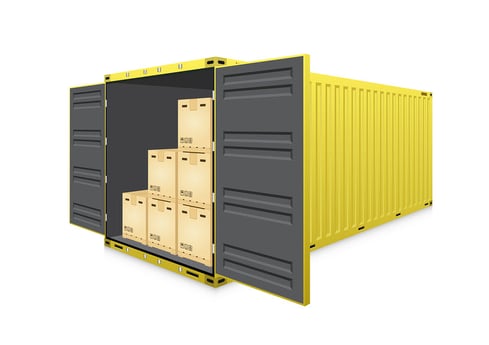In today's global economy, international trade has become integral to the success of businesses, large and small. Particularly for small and medium-sized enterprises (SMEs), leveraging the right shipping options can certainly increase company profits. This is where LCL (Less than Container Load) shipping comes into play, offering an adaptable and cost-effective solution for smaller shipment volumes.
Introduction to Container Shipping
 Let’s first talk about container shipping – a method of transporting goods in large, standardized shipping containers. Containers revolutionized global trade when they were introduced in the 1950s. The most common sizes are the 20-foot and 40-foot containers, each with specific dimensions and capacities.
Let’s first talk about container shipping – a method of transporting goods in large, standardized shipping containers. Containers revolutionized global trade when they were introduced in the 1950s. The most common sizes are the 20-foot and 40-foot containers, each with specific dimensions and capacities.
20-Foot Containers
- Dimensions: Typically, a 20-foot container is 20 feet long, 8 feet wide, and 8.5 feet high.
- Internal Volume: Approximately 33 cubic meters (CBM) – 1,172 cubic feet.
- Pallet Capacity: Can generally accommodate 10 standard pallets (48" x 40") in one tier.
40-Foot Containers
- Dimensions: A standard 40-foot container measures 40 feet in length, 8 feet in width, and 8.5 feet in height.
- Internal Volume: Roughly 67 cubic meters (CBM) – 2,389 cubic feet.
- Pallet Capacity: Hold 20 standard pallets (48" x 40") in one tier.
These containers are easily stacked and transported over long distances, offering a secure and efficient way to move large quantities of goods.
LCL vs FCL Container Shipping
LCL shipping is an ocean shipping option where multiple shippers share space within a single container. Unlike Full Container Load (FCL) shipping, where a shipper utilizes an entire container, LCL allows for a more flexible and economical approach. This method is ideal for businesses that don't have enough goods to fill an entire container, as it enables them to pay only for the space they use while other cargo takes up the remaining space. LCL's shared approach contrasts with FCL's exclusive use.
When you use LCL container shipping services, you ship your freight to a Container Freight Station (CFS), where a consolidator loads it into a container, along with freight from other customers. Let’s say you’re shipping two pallets of product from the U.S. to Poland – that cargo might share a container with cargo headed to Germany, Slovakia and the Czech Republic. In this instance, you pay just a fraction of the cost – as much as 60% less – vs paying for a full container.
There's no universal rule for when a shipment should transition from LCL to FCL, But a rule of thumb is that if cargo can fill more than half of a 20’ container, the economic benefits of LCL shipping dissipate. Half or less and LCL container shipping might be your best bet.
If you’re in that half-a-container range, it’s always a good idea to ask your service provider to provide a rate for both LCL and FCL.
The Cost Benefits of LCL vs FCL are Not Always Straightforward
There are many factors at play when deciding what shipping strategy to use. You can’t always apply a simple mathematical formula. Some thinking is involved.
Example: When your shipment volume exceeds the limits of a full 20' container, you must decide if you should ship FCL in a 40' or FCL in a 20' and then, for the remainder, LCL in another container. Partnering with an experienced freight forwarder like I.C.E. Transport ensures you utilize the most effective shipping method that prevents you from overpaying for ocean freight shipping.
Beyond just the costs, there are other factors to consider, such as the speed and frequency of shipments. LCL might offer cost savings, but sometimes at the expense of longer transit times due to the need for cargo consolidation and deconsolidation. Are your customers OK with that?
Advantages of LCL Container Shipping
Less than container load shipping holds many benefits for smaller volume shippers. Key advantages include:
- Cost-Effective for Small Volumes - LCL allows businesses to pay only for the space they use.
- Flexibility - LCL allows shipping of smaller amounts more frequently without waiting to accumulate enough cargo for a full container. That could make customers happy.
- Ideal for Diverse Cargo Types - LCL is suitable for a wide range of goods, offering an adaptable solution for different cargo types.
- Enhanced Inventory Management - With LCL, businesses can manage their inventory more effectively, reducing storage costs and enhancing supply chain efficiency.
- Access to Global Markets - LCL makes international shipping accessible and economical for smaller businesses, allowing them to participate in global markets without onerous shipping costs that make them less competitive.
For more ideas on shipping strategies for small-volume shippers, read our guide on International Shipping for Small Businesses.
How Do I Know if LCL Shipping is the Best Option?
Understanding and leveraging the advantages of LCL shipping is critical for smaller businesses. Under the right conditions, this method offers flexibility and cost savings when shipping smaller volumes.
But determining exactly when to leverage LCL container shipping vs FCL isn’t always obvious. That’s why it helps to work with an experienced freight forwarder and NVOCC like I.C.E. Transport. We have decades of expertise in international shipping and can advise you on the best strategies for your business. I.C.E. Transport’s bespoke solutions get your cargo there on time and in the most efficient way possible. Contact I.C.E. Transport today to learn how we help small to mid-sized shippers compete through more efficient global shipping.




